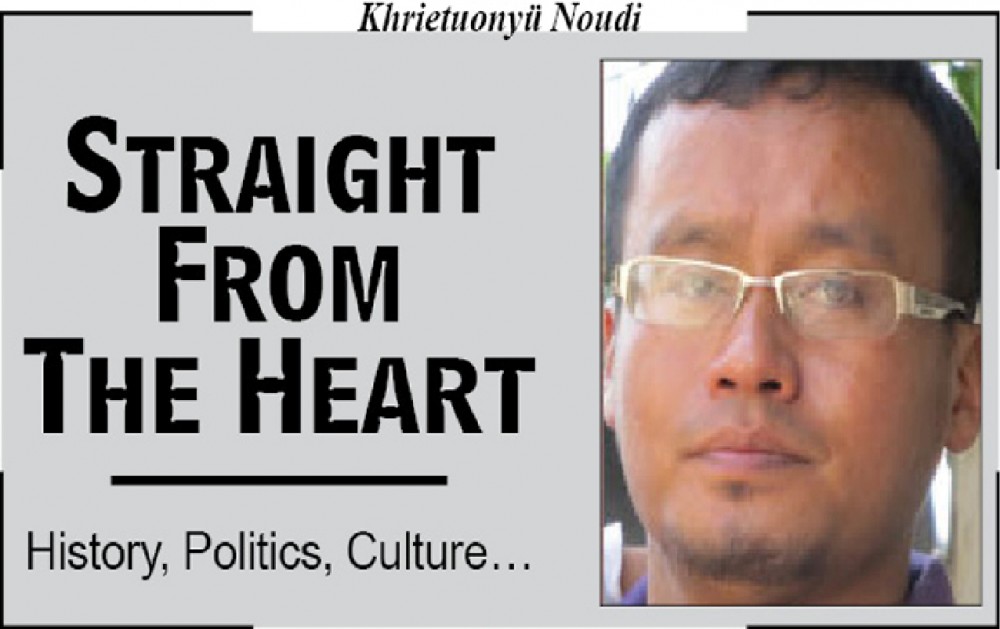
Every Naga alive today is a direct by-product of three mega episodes that have permeated and infiltrated our society, our mindset and our lifestyle in such a way that it seems like these episodes have almost become a part of the Naga DNA. For centuries, Nagas lived without any contact with the outside world and our social fabric and mindset remained somewhat undisturbed, uncorrupted and unprovoked by any outside element. But in the second half of the 19th century, some people from across the seas landed in our lands with a message that was let loose in Jerusalem almost 2000 years ago after a man who was crucified on a Roman cross rose again from the grave. This is the first episode of the Naga trilogy.
Then in the first half of the 20th century, some Nagas who went to Europe as labor corps and witnessed the Great War of 1914 – 18 came back home and stirred political consciousness amongst us which ultimately resulted in an unrelenting fight for political sovereignty and independence -first with the then British colonial power and later on with our mighty neighbor India. This is the second episode of the Naga trilogy.
The third episode of the Naga trilogy happened in the second half of the 20th century when the Indian government and some Nagas connived and brought about the Naga statehood in order to placate the greater majority of the Nagas who had been adamant and unrelenting on their demand for a fully independent and sovereign Nagaland.
Today we live in the remnants of these three episodes of the Naga trilogy. And how much of a Naga you still are will be determined by your views and take on these three chapters of the Naga trilogy. Let us consider these three episodes one by one.
1. Advent of Christianity
1872 is the year officially recognized as the year when the Nagas’ tryst with the gospel began. That was why we celebrated our centenary in 1972 with Billy Graham. Today we claim that more than 95 % of the Nagas are Christians and there is a church in every town and village of the Nagas. But what are your views and opinions of this gospel message which our forefathers accepted more than a hundred years ago and passed down to us? Do you think that this is just a religion like any other religion? Or do you think that the gospel is something much deeper and beyond the realm of religion? Your views and opinions on this will determine whether you have really encountered the grace of the risen savior or whether you have just shifted from our ancestral beliefs to a new foreign religion.
2. The Naga Political Movement
When the Naga labor corps went to Europe and witnessed firsthand the spirit of patriotism and people fighting and dying in defense of their motherland, they realized that the Nagas were yet to rise up from their slumber as far as political consciousness and patriotism were concerned. Therefore, upon their return, the members of the corps did their critical part of stimulating political awareness and consciousness amongst their fellow-beings. This ultimately resulted in the formation of the Naga Club in 1918 and the submission of the Naga Memorandum to the Simon Commission in 1929.
Upon the impending departure of the British from the Indian sub-continent in the mid-1940s, the Nagas did everything humanly possible to make their stand loud and clear that they should not be thrown into the sea of Indian politics. But all their pleas and petitions fell on deaf ears as both the outgoing British government as well as the incoming Indian government did not think that the Nagas were important enough to be given a political consideration. But as the Nagas remained adamant and unrelenting, the Indian government was ultimately forced to do the unthinkable i.e. deploying its mighty military army on poor unarmed and innocent villagers resulting in untold sufferings, genocide and crimes against humanity. This political issue of the Nagas is yet to come to its logical conclusion and continues to be a thorn in the flesh of India.
So, as a Naga, what are your views, opinions and stand on this Naga national movement in which once every Naga participated voluntarily and which was once very close and dear to our heart? Do you think the Naga national movement was an unworthy episode of our history? Or do you think the Naga national movement was the noblest and most righteous stand ever envisaged by the Nagas? And do you think the sufferings and sacrifices we endured to be recognized as a distinct people was well worth it or do you think that these were unnecessary and meaningless toils? If you think that the Naga national movement was a noble and righteous stand, I congratulate you for not having lost your sense of heritage, identity, pride and history as a Naga? But if you think the Naga movement was an unnecessary evil, then it would be worthwhile to look around and realize where we stand today as a people. Most of the privileges, recognitions and benefits we enjoy today are all direct by-products of the Naga National Movement.
3. The Naga Statehood
The third chapter of the Naga trilogy is the Naga statehood which was officially born on 1st December 1963 under extraordinary circumstances. Yes, it still gives me goose bumps to think how a small population of people could become the 16th state of the Indian Union where the other states were comprised of crores and crores of people. All these tell us how much intense, ferocious, genuine and relentless the Naga movement must have been. The Naga statehood was brought about by the then Indian government in order to placate and pacify the Nagas.
And after the Nagas became a full-fledged state of India, many things in our land took a drastic change. The leaders who connived with the India government and brought about the statehood started proclaiming themselves as the savior of the people. And in one sense, it may seem true also. But we have to realize that the Indian government relented to a Naga statehood only because of the strong and adamant stand taken by the leaders of our Naga movement. In other words, there would have been no Naga statehood if there had been no Naga national movement. And thus we should give credit where it is due.
The Naga statehood was born through the signing of the so-called 16 Point Agreement. And a clause of this Agreement says that the Nagas would be financially supported through the Consolidated Fund of India. And after that, government jobs and govt. schemes and projects became the most sought after commodity in our land. And most Naga began to live expecting only the resources that would come down from Delhi rather than finding livelihood and fulfillment from the resources that are locally available. And as of now, the Naga society seems to be surviving totally dependent on outside resources.
So what are your views and opinions on this Naga statehood? Do you think that it is the best thing to have ever happened to the Nagas? Or do you think that the Naga statehood is a necessary evil? Do you think that the Naga statehood should be considered the final settlement or should it be totally abrogated? Or should we cry out for a more refined and enhanced version of the statehood?
If you are satisfied with the Naga statehood or think that the Nagas need not ask for more, then I would say that our adversaries have already achieved their desired objectives and gained a permanent foothold in our mindset and thereby in our lives. On face value, one may be tempted to think that the signing of the 16 Point Agreement saved our land and people from total annihilation. But let us recall that we had never demanded for statehood within India.
Every Naga alive today lives under the shadow and outline of these three episodes of the Naga trilogy whether we realize it or not. And no matter how hard we try to deny or outrun the Naga trilogy, we cannot escape because we were all born into it. The moment we came out of our mothers’ wombs, we were embraced by the Naga trilogy and we all grew up in the midst of it and whether we realize it or not, the trilogy has shaped and moulded our path and destiny thus far. And since we live in the remnants of this trilogy and it will continue to be a part and parcel of our society and mindset for a long time to come, it is vital for us and our children that we separate the myth from the truth as far as the Naga trilogy is concerned.




